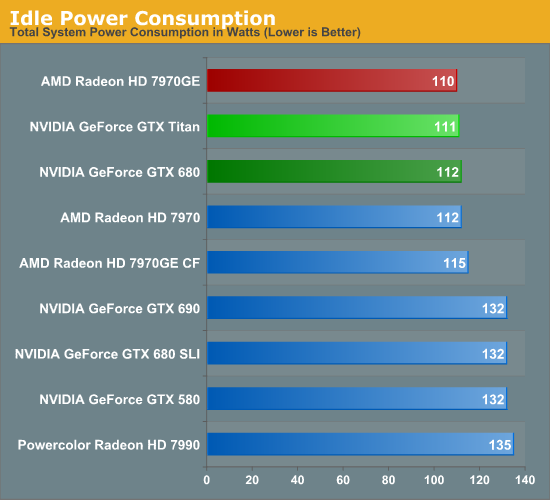Ok I get it - idle was a bad choice of word - but if only 1/3rd of the total memory is being used then that's using less power than if all of it is being used.
I guess the power draw numbers themselves are pretty low even if all 6GB was 100% utilised. Basically, the extra (mostly underutilised) 3GB on Titan is contributing a couple of extra Watts in power (over the 7970) and not a lot more than that I'd imagine?
The low idle power draw of Titan even though it has 6GB vs 2GB on the 680 would seem to support the notion that memory is not really much of a consideration in terms of power draw.
What I am saying when it comes to power we have 3 scenarios: One which show Nvidia, same amount of power, less than the amount of power. using more power.
If we take an average from all these reviews, we probably get something along the lines of same amount of power, or slightly more or less than this. Add in that Nvidia has twice as much memory and it probably uses less for purely the chip. But lets give AMD the benefit of the doubt and say it uses the same.
I think a lot of efficiency comes from being smaller chips with less complexity. Also Pitcairns didn't come that much later than tahiti. The launch came only 2 months after. Much of pitcairns efficiency comes from the fact that it basically sits at the sweet spot where adding components to the design yields less the parts added. Hence why the difference between it and tahiti is less than the sum of its parts of the latter. The same thing happened between the 5870 and 6870. As a result, you get a huge boost for performance per watt with a significantly smaller die. However, you don't get the same effect when you add more to a big chip and you will typically bring efficiency lower. What you can do is lower clocks to combat the effects of having a larger die.
Lets be honest here. Even though you guys want AMD to have the performance crown, it wide be a prideful and wasteful effort considering they don't have a strong professional market to make the R and D worth it(not to mention the wasted wafers).
AMD's likely and best course of action, is just another revision/respin of its current 7970 with a later stepping clocked higher with less headroom available. Perhaps in the 1150-1200mhz range. Nvidia is likely to do the same thing with GK114 and eventually gk110. So beside titan they won't be at much of a particular disadvantage. They will likely gain more than Nvidia from this type of move because that 256bit but on gk1x4 is starting to catch up with them. Also I think AMD already planned this, which is why initially the 7970's were clocked so conservatively initially. This also lines up with the more believable rumors from Charlie.
It just doesn't make as much sense to spends such tremendous R and D when the market is shrinking.
AMD game bundling approach has been successful so far, so it might be a more fruitful effort to spent money on marketing than a vanity project like a titan beater.

